Remote project management is more important now than ever before, and that’s likely to continue in a post-pandemic world.
But whether you’re quarterbacking an installation from across town or out of state, the issues you’ll face are often the same.
It’s easy for information to get lost without a good system in place to help teams stay organized, leading to missed deadlines, increased costs, and unhappy customers.
In this article, we’ll cover some best practices that you can use to improve how you manage projects from afar.
Let’s jump right in.
- Why is remote project management so hard?
- Consolidate all project information in one place, not across multiple systems.
- Use systems that clearly display project information and all relevant instructions.
- Standardize installation processes across all locations.
- Create approval workflows for contingency plans and create default workarounds for known trouble areas.
- Make it easy for field teams to seek quickly resolve problematic issues.
- Establish and follow a process for installation quality control to drive accountability.
- Use systems that allow project leaders to plan ahead for future workloads.
1. Why is remote project management so hard?
According to one study, most PMs (59%) are managing between two and five projects, with up to 15% of PMs managing more than 10 projects at a time! If you’re a PM in this situation, you’re already stretched thin.
Even if you aren’t split across multiple projects, you can still find yourself managing subcontractors across a number of sites, in addition to managing your teams, working with other trades, keeping the customer in the loop, staying on top of inventory, and ensuring profitability of the project.
It’s not easy, especially when you’re managing multiple projects. There are just too many moving parts.
Today’s PMs need tools that can help bridge the gap between the office and the field, create clear team priorities, drive accountability and validate the quality of installation work.
2. Consolidate all project information in one place, not across multiple systems.
One of the biggest challenges in multi-site management is that a single project is actually a collection of smaller, sub-projects with their own scope.
Everything from parts information to installation instructions needs to flow from the sales and engineering teams to the techs in the field. In a perfect world, all of these details would be kept together in an organized fashion where PMs, site managers, and stakeholders have access to them.
But the reality is often very different.
Techs rely on paper-based designs and handwritten notes for installation instructions. Meanwhile, the actual installation information — such as devices installed, commissioned, and tested — is stored somewhere that may be completely out of reach for technicians and installers. Meanwhile, inventory and parts information is archived on a completely different system!
The result? Complete chaos anytime something goes awry. Project managers are forced to scramble between multiple systems in order to make sense of the problem and find a solution.
You can streamline multi-location installation projects by minimizing the number of systems your team has to access in order to get the job done.
This is possible with some ERP systems or custom-built software, or by using an open-ended file-sharing system like Dropbox and creating a ton of nested folders. But many popular project management tools are so clunky that they can become obstacles to strong project delivery.
On the SiteOwl platform, we solve this problem using the visual dashboard.
With the visual dashboard, multi-site projects become much easier to organize and maintain because the number of plans, devices, and tasks for each site is immediately visible all from a single location.
Plus, all relevant information is stored behind every line item on the project roll-up. SiteOwl stores all information for each project, including floor plans and the devices that are assigned to any plan and associated system layout.
However you choose to do it, the ultimate goal is to reduce both the number of files and the time that your team spends trying to access the relevant information that they need to complete the job.
The more files you have, the greater the likelihood that team members who aren’t as comfortable or savvy with your technology tools will waste time searching for the information they need to get the job done
For PMs managing jobs remotely, this leads to unnecessary calls, over-the-phone troubleshooting, and team confusion while everyone struggles to get on the same page.
3. Use systems that clearly display project information and all relevant instructions.
Lack of clarity and communication is one of the main reasons that projects slow down. That’s especially true for team members who are working remotely.
If you’re already nodding your head in agreement, you’re not alone. According to one survey, 46% of respondents said that lack of communication was the biggest challenge for managing remote workers.
And any project manager knows all too well how a lack of clarity in the field leads to phone calls, delays in project execution, and budget overruns. All of this is made worse by the fact that most project managers are busy handling other projects when something goes wrong.
When managing a multi-site project, the sheer amount of information required to keep everything running smoothly means that the few individuals who have access to the important details become a bottleneck during critical moments.
You can get around that by taking advantage of systems that clearly display all project information and all instructions required to complete a task or project objective.
Here’s a closer look at what we mean using SiteOwl as an example.
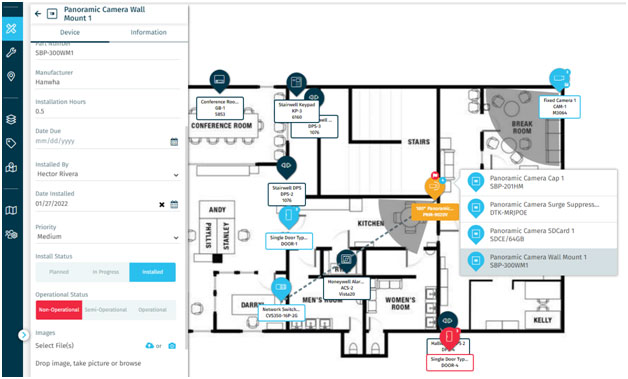
In SiteOwl, we use visual floor plans and installation instructions to organize and bundle all relevant information that a technician needs.
Not only does this make it easier for technicians to know where and how to install devices; it also provides a bird’s eye view of the entire project so that they can better understand how their contributions move a project toward completion.
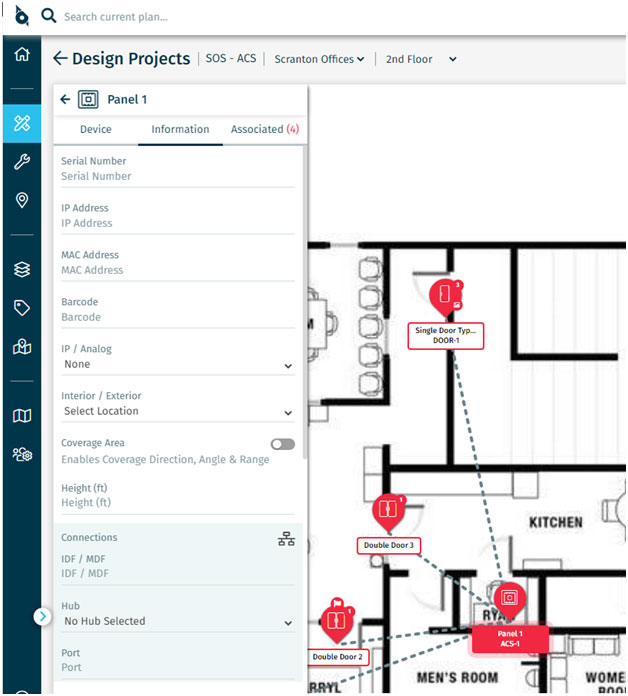
The floor plan notates precisely where a device and any accompanying equipment should be installed, so nothing is left to chance. This ensures that technicians have everything they need before they visit a job area, which minimizes extra trips for forgotten items while helping to keep objectives clear.
But what if you aren’t using SiteOwl?
It’s still possible to do this by bundling as much information as possible into installation packages that your field managers can distribute to technicians as tasks are assigned. Techs won’t have global visibility on a given project, and working from spreadsheets will ultimately be less clear than having visuals, but savvy technicians can make do.
The biggest problem with creating such a streamlined workflow is that it takes a considerable amount of time to break down every single installation into clear and actionable steps.
That time could be put to better use managing other projects and coordinating other teams, especially considering that a software solution like SiteOwl could do most of the heavy lifting for you.
4. Standardize installation processes across all locations.
While every multi-site project is a little different, you can alleviate many pain points by working with your teams to standardize your installation processes across every location.
While some software tools can help with this, it’s ultimately up to PMs, teams, and project stakeholders to determine the best strategy for installation and deployment.
Work with project stakeholders who have some level of understanding about how the business operates and see if it’s possible to reach a mutual agreement regarding access and availability during the installation process.
In many cases, the buildings that the field team needs to work in may not cease operation during the install, meaning that technicians may not have access to the entire building all at once.
At the same time, while customers will tolerate some level of workplace disruption during the installation, integrator teams still need to respect their surroundings and their environments.
For multi-site deployments, try to develop an installation workflow that can be replicated across almost every site.
A defined and consistent process will not only help your project run smoothly but also elevate the customer experience as your teams move seamlessly through the project with minimal hiccups or disruption.
If you’re aiming for a transparent, no-surprises environment, creating a uniform workflow for every project (and documenting that so you can replicate it with future projects for the same customer) is the way to go.
5. Create approval workflows for contingency plans and create default workarounds for known trouble areas.
No matter how well you try to plan things out, it’s a given that something will go wrong.
And when they do, PMs usually get a phone call.
That’s because dispersed teams often don’t know what to do when they can’t stick to a preassigned plan. In fact, 88% of remote workers say that they face inconsistent leadership and miscommunication with other team members.
Put another way: When something goes wrong, nobody knows what to do or what authority they have to act on their own.
One way to mitigate these issues is to create a preset set of contingency plans that are attached to an approval process.
These plans need to be flexible, but not overly broad, and the level of approval should scale with the scope of the problem.
For example, if a technician can’t pull a cable through a given area because of an unexpected obstruction, some level of leadership and support may be required to resolve that issue. However, it’s also possible to create a predefined workflow to expedite that consultative process.
In SiteOwl, we handle this through device flags. Technicians are able to flag blockers in the field using the software so that Project Managers can assess the issue without ever setting foot on site.
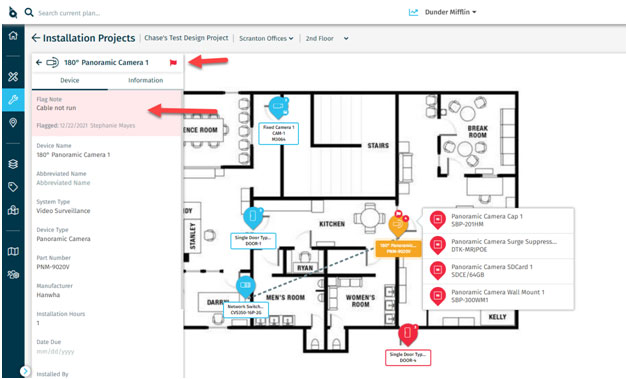
At the same time, some contingencies may need approval from customers, and you’ll need to notify them prior to making unexpected changes to the existing floor plans or security designs.
While every customer and every project are a little different, you’re probably familiar with some of the more common issues that your team encounters on a regular basis.
Once you isolate those common issues, consider seeking pre-approval from stakeholders regarding workarounds and unexpected problems in order to minimize project delays.
For issues where a project manager has to get involved, taking extra steps early can help to offset your own workload and remove yourself as a bottleneck.
For everything else, getting everyone on the same page and delegating the authority to make decisions when technicians encounter unforeseen issues can massively expedite project delivery.
6. Make it easy for field teams to seek quickly resolve problematic issues.
Piggybacking off of our previous tip: If you’re a PM, what needs to happen in order for you to be involved when problems arise, and what do you actually need to know in order to resolve an issue quickly?
If your team already has a contingency plan in place to sidestep minor issues, they may only reach out for issues that require higher authority and need to be resolved on a case-by-case basis.
That’s understandable, but it’s also possible to standardize this process to some degree so that these interactions are smooth and effective.
With multi-site and out-of-state projects, this is critical if you’re a PM working out of a central office hundreds or thousands of miles from the job site.
When the field team comes to you for assistance, you won’t be much help if you’re operating with limited information and no way to understand the problems that the team is experiencing.
Nailing down exactly what you need in order to accomplish this goal can be tricky, and you may have to coordinate with your field team to find a solution that works every time.
One of the fastest ways to stay connected is to use tools that keep all information organized and updated in real time.
If you’re using a cloud-based ERP system or a platform like SiteOwl that immediately updates all users with the same information, you can dramatically reduce the amount of time it takes to get your hands on critical information.
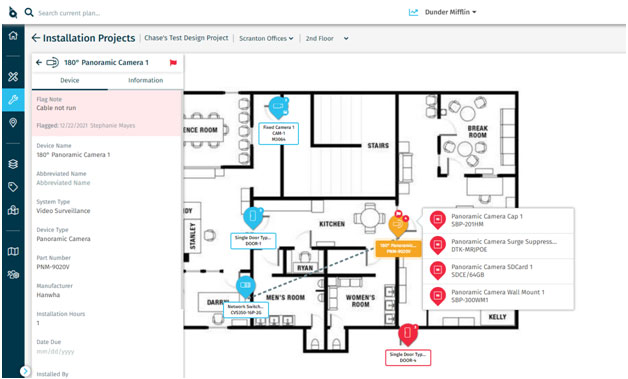
SiteOwl allows everyone to get information about a specific device by tapping on the device pin in the digital floor plan. Technicians can leave notes or submit additional pictures, which PMs can access from anywhere and review before helping teams troubleshoot.
Immediate access to key information not only helps to reduce confusion and resolve critical issues; it also prevents the need for additional project stakeholders to get pulled into unnecessary conversations.
7. Establish and follow a process for installation quality control to drive accountability.
One of the biggest challenges with remote project management is understanding how your team determines priorities and executes their assigned tasks.
It’s frustrating for any PM to be the last one to know when something goes wrong and still be expected to find a solution.
If that sounds familiar, you’re not alone. Among PMs everywhere, nearly one-third say that knowing what each team member is working on, as well as when they’re working, is a major challenge.
Accountability is also a huge problem for integrators — and it deserves special attention — especially considering the ongoing labor shortage and the reliance on subcontractors to perform quality work on tight deadlines.
As a PM, how do you know that the work is done correctly? Most integrators don’t find out about shoddy workmanship until months later, when a customer complains or when equipment begins to break down prematurely.
It’s possible to solve most of these problems by implementing quality control processes that drive accountability. For subcontractors, that might be as simple as having a trusted team member verify the quality of their work or mandating that each technician submit formalized reports as tasks are completed.
The problem is that these things take time and generate a mountain of paperwork, especially if you want to have a documented process for customer review.
In SiteOwl, you can solve this problem by requesting verification images to validate that the work has been completed and that it conforms to your standards.
SiteOwl also automatically tracks which users and technicians worked with a device, providing a clear chain of accountability from design all the way to installation. That way, if something goes wrong, it’s always easy to review technician documentation and determine how best to follow up.
These processes happen automatically, so technicians don’t have to worry about filling out additional paperwork or creating new processes. Those accountability records are generated as technicians interact with the software based on their user accounts.
8. Use systems that allow project leaders to plan ahead for future workloads.
If you’re already working on a multi-site project, it’s easy for that project to scale and grow more complex during and after the job is complete.
If the customer is satisfied with the company’s work and needs to expand their security coverage to another floor or another building, it makes sense for them to partner with your team again.
That’s why it’s critical for PMs managing multi-site jobs to leverage systems that can facilitate future growth as projects and systems evolve.
In SiteOwl, you can use project notes and instructions to help teams isolate opportunities and create consistent processes for quality project installations.
Savvy PMs know that planning for the future is all about creating strong processes and systems that can facilitate that future growth when it finally materializes.
That comes down to good record keeping and a strong adherence to best practices. If you’re using flexible systems that allow you to create a collected body of deliverable work, scaling up is simple.
This is where SiteOwl comes in handy from the aspect of categorization and organization.
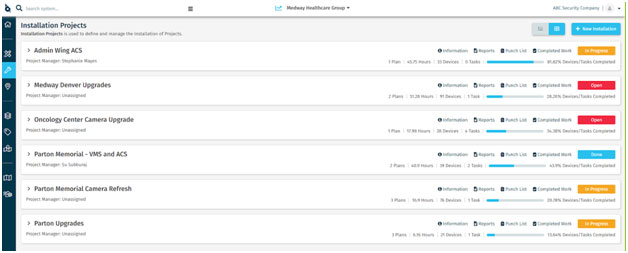
When it’s possible to view real-time progress across all of your installation projects across every location, it’s easier to plan resources for future projects.
Using SiteOwl Live, customers can manage their security systems after installation projects are complete. This adds even greater value to your deliverables because customers will inherit the documentation of labor that your team creates while designing and installing their systems.
The level of service and quality that comes from staying organized is also key in becoming a strategic security partner for your customers.
Better Remote Project Management with SiteOwl
Staying on top of projects can be a major challenge when you’re not on the job site, but it’s possible by leveraging the right workflow and the right technology.
Especially during large and multi-site installations, modern project management platforms like SiteOwl use cloud-based technology tools to bridge the gap between project managers, installation teams, and customers so that everyone can stay up to date on project progress.
Want to see it in action? Contact our team for a free demo to learn how the SiteOwl platform can fit into your existing project management workflow.







